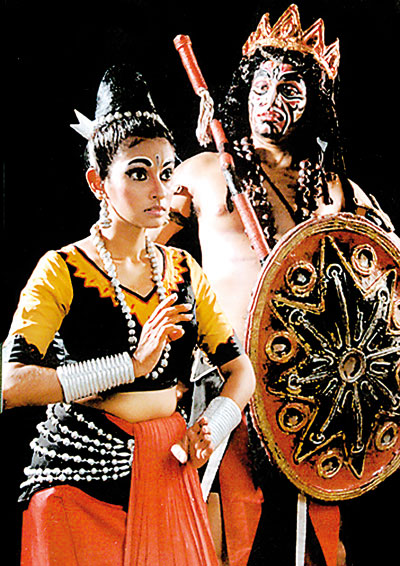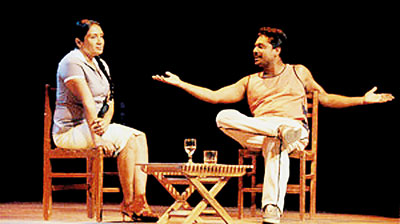Sunday Times 2
Where truth lingers: 75 years of figurative language
View(s):By Dr Madhubhashini Disanayaka Ratnayake
What talk of art and literature in the 75 years of Independence, one might ask, when our focus is now more on survival than aesthetics. Yet it is relevant, always relevant, I feel, for in words lie the heart of a nation that is quiet, unlike mass media; is subtle, unlike mob rule and hysteria; has the capacity to speak truth to power, unlike many of its ordinary citizens like us.
A few days ago, I watched Rajitha Dissanayake’s drama Sihina Horu Aran(Dreams Robbed) where a young man’s fate encapsulates the fate of our youth here: The only future available for him is to either go abroad somehow, or become a murderous politician’s stooge – he cannot even kill himself. The quiet audience taking this all in knew what the playwright knew: We are living in a country where hope is dying. But art matters, because, for whatever it’s worth, it tells us that we are not alone in our desperation, and that alone is something.

A scene from Maname
Current dramatists have captured a mood and a fate, and put it on stage: Asanka Sayakkara’s Ayya Malo (Brothers/and also ‘The Elder Brother is Dead’) puns on the title, or Chamila Priyankara’s Sanga Veda Guru Govi Kamkaru, by the very title itself frames what led this nation into a path of exclusivist nationalism, for which Sri Lanka has paid quite a heavy price, its citizens still being unable to think outside ethnic divisions even after 75 years of living together.
The birth of this exclusivist nationalism itself cannot be separated from the fields of drama and literature either. In fact, the beginnings of Sinhala fiction, in which Piyadasa Sirisena and his polemic novels played a main part, are tied to the urge of those pre-Independence writers to show up the faults of the colonizers and their Western way of life. A fertile ground to bring forth such resistance was already made in the 19th Century with the Buddhist Revival Movement in the South brought about by figures like Waliwita Saranankara Thero and Colonel Henry Steele Olcott, and Navalar’s Hindu Revivalist movement in the North. In drama too, the theatre of John de Silva and so on was doing more or less the same thing. According to Ediriweera Sarathchandra, the coming of age of the Sinhala novel, when art superseded politics, was Martin Wickramasinghe’s novel Gamperaliya in 1944. Sarathchandra’s own dramatic production in 1956, Maname, is believed to have ushered Sinhala theatre into its own identity, the fact that it was a construction taking many elements of world theatre, according to the playwright’s own admission, not being given much attention. Names itself, like the playwrights, were constructed for well known artists during that time, erasing all Western sounding names they originally had; it was, after all, a time when linguistic nationalisms were at its height, with the Sinhala Only Act coming into effect the same year.
After the British left, there came a time in the 1960s and the ’70s where there was a strong sense of leftism both in art and the country. In literature, this marks a rare time of both Sinhala and Tamil writers working on the same wavelength, the latter including some Muslim writers as well according to M.R. Nuhuman. The Sinhala Janatha Lekeka Peramuna and the Tamil collective called the Sri Lanka Progressive Writers Association worked within more or less the same ideological framework, and writers like Ayathurai Santhan still speak fondly of finding himself at home in both. Even in drama, as Kanchuka Dharmasiri has shown, there had been close links earlier between the Sinhala and Tamil dramatists, and both groups objected in their art in the 1980 and 90’s to the coming of neo-liberalism to Sri Lanka which happened with the opening of the economy in 1977, against which Gamini Haththotuwegama’s street theatre group founded in 1974 also gave powerful social commentaries, acting their dramas out in open spaces around the country. Tamil theatre disappeared from Colombo after the 1983 riots, contends Dharmasiri, and didn’t quite flourish elsewhere either, as many artists either migrated or were displaced.
The JVP uprising in the late 80s saw drama become one of the most powerful places of protest, resistance and public expression, when that was often punished by death in this country at that time. I still remember the catharsis expressed by the audience’s reactions each night, when Dharmasiri Bandaranaike’s Sinhala adaptation of Jean-Paul Sartre’s Men without Shadows was enacted, for which I played the violin under Premasiri Khemadasa’s baton. It may have been the French Revolution the actors were depicting, but the audience knew that the torture shown and the deaths of idealistic young people had everything to do with here. There were many such plays then, perhaps the only mode of release was art in those times of terror, as Ranjini Obeysekera had called that era, in her book about theatre then.

A scene from Sihina Horu Aran
If protest and resistance left drama after the carnage of the ’88-’89 JVP uprising, it seemed to have moved into fiction during the long war that followed, the point to where an exclusivist nationalism had finally led us. In the decade after the war ended in 2009, Sinhala fiction – at least that written by the best in the field right now – speak against violence, injustice and the fault-lines in Sri Lankan politics. They do so openly, the cover, if at all, by some, is in allegory and symbolism; they are often multiple State Literary Award winners like Liyanage Amarakeerthi, Keerthi Weliserage, Sunethra Rajakarunanayaka, Kaushalya Kumarasinghe to name just a few who generally write in the realist vein, or fabulists like Reverend Batuwangala Rahula, Prabath Jayasinghe or Piyal Kariywasam. There are superb new writers emerging as well, both in fiction and poetry. There is hope in the field of drama too as mentioned at the beginning; in English theatre, plays like Ruwanthi de Chickera’s Dear Children, Sincerely, or those created by Tracy Holsinger’s Mind Adventures Theatre Company show how engaged with current politics English theatre can become as well.
And that is what makes me end this short look back with a note of hope. In the midst of general devastation, Art still lives here.
(The writer is a senior lecturer at the Department of English Language Teaching, University of Sri Jayewardenepura. Her PhD dissertation was on post-war Sinhala and English fiction in Sri Lanka)

